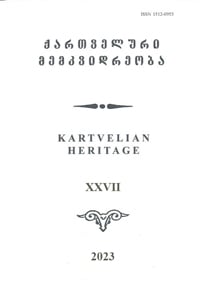MYSTERY OF A NOTE IN THE ATHOS POLYCEPHALON
DOI:
https://doi.org/10.52340/PUTK.2023.27.20Keywords:
Georgian manuscripts, Old Georgian ecclesiastical literature, the Athos Polycephalon , 10th centuryAbstract
The Athos Polycephalon, dating back to the 10th century, has garnered special attention from researchers since its discovery. It offers a unique opportunity to draw significant conclusions about the historical and cultural spaces of Tao-Klarjeti. Additionally, it includes texts that have not been preserved in other manuscript forms. One such text is ‘The Martyrdom of the Children of Kola,’ which recounts the intense story of the struggle between idolatry and Christianity in the Kola Valley. Dating the text or its alleged written source with more or less accuracy would offer an in-depth understanding of crucial issues within the context of Georgian historical and religious culture. However, this task has eluded scholars for almost two centuries. In this regard, we believe the inscription made on the margin of the Athos manuscript is of utmost importance. According to this inscription, the Children of Kola were tortured “during the time of the rule of Dorime, master of Samtskhe, who was an Idolater by belief.” Unfortunately, this information has not received proper attention in scholarly literature, even though it adds valuable insights into the political-geographical domain of the text and the chronology of the events within it. In our opinion, it is connected to other inscriptions on the manuscript featuring the bishop Arseni, which we believe should have been copied from the original. The inscriptions, along with information from other sources, have allowed us to pose some logical questions, specifically, whether Arseni, the bishop in the manuscript, could have been a disciple of Grigol Khandzteli, who was appointed as the Catholicos of Kartli in the second half of the 9th century. In this context, it should also be considered that, being from Samtskhe and the son of a nobleman of Samtskhe, he had access to ancestral chronicles or records of that area that may be unknown to us. In our opinion, the author of the inscription about Dorime should be either a monk who moved from the Tao-Klarjeti Monastery to Mount Athos or a figure from the Mount Athos of Samtskhe origin, specifically from the Chorchanel-Chordvaneli circle. They could have had access to this information through genealogical chronicles of Samtskhe feudal lords or from other sources.

